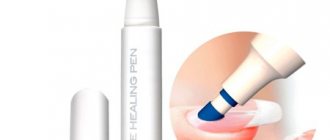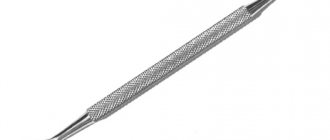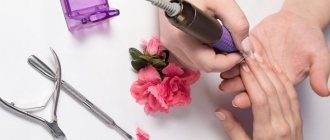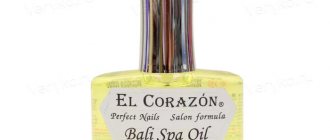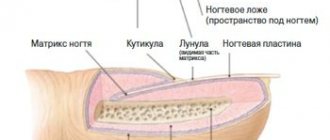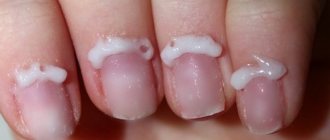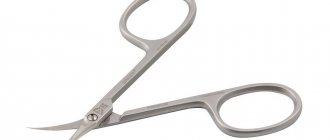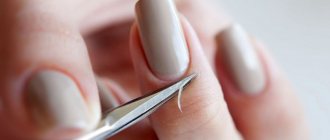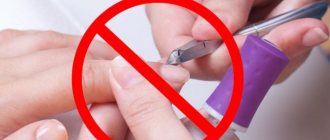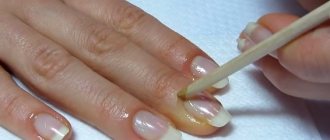Before you figure out how to properly trim the cuticle, you need to find out what other ways there are to remove this skin. There are many types of manicure, but they are all divided into two large groups according to the method of removing the cuticle:
- Trimming, also called classic, involves removing the cuticle by cutting it with special tools or nippers
- Unedged involves the use of special softening agents, after application of which, dead skin is easily removed with a pusher. Another unedged type is considered a hardware manicure. A special machine with a rotating tip has attachments of different functionality, including for removing cuticles. But this method can be traumatic, since the torque can touch sensitive skin or nail plate
The advantage of edged manicure is savings, since you do not need to additionally buy special softening agents. Another advantage of this procedure is its simplicity and accessibility. To cut the cuticle, you don’t have to go to the salon, but do it at home without much difficulty.
But this manicure also has disadvantages, the most important and dangerous one being injury.
Careless movement when removing the cuticle can cut off living and sensitive skin along with dead tissue.
This is not only very painful, but also threatens with consequences such as redness and inflammation of the skin, and infection. This is one of the main reasons why women are switching to the European unedged version. Another significant disadvantage is the speed of cuticle growth after removal by this method, it begins to grow faster. This procedure is contraindicated for people with poor blood clotting, fungal and other nail infections, capillaries close to the surface.
The unedged type is safer as it does not require the use of sharp tools. Emollients tend to slow down the growth of the cuticle, giving it softness and plasticity. Most good salons use this method.
Why do you need to remove cuticles?
Many girls believe that it is impossible to remove the cuticle, since it performs a very important protective function, but this is not entirely true. The cuticle really protects the nail from irritants, but the edge of this protective strip consists of already dead cells.
On the contrary, not removing the cuticle can lead to various kinds of troubles, for example, the appearance of hangnails.
Tips for choosing scissors
- For use, you can take absolutely any specialized manicure scissors.
- They should fit comfortably in the hand, as well as fold and move well.
- The most suitable tool would be scissors with “hand sharpening” status. Such manicure accessories have the sharpest blades, which will ensure the convenience and quality of cuticle removal. In addition, they will last longer than usual.
- But do not forget that scissors should be sharpened by giving them to professional craftsmen at least once a year. Then every job with them will be a complete pleasure.
Cuticle remover
What is a remover? A cuticle remover is a cuticle remover that helps soften the skin around the nail plate, making it easier to remove. They come in the form of a cuticle remover gel, liquid or cream formulation. Some people use oil to remove cuticles, others use mineral or acidic products.
It should be noted that the density, composition and release form of the remover do not affect the result of its action on the skin. Therefore, you can choose what is more pleasant and convenient for you to use.
What to choose: scissors or cuticle nippers
The Ukrainian market offers many options for tools for manicure and pedicure. It’s easy to get lost in this variety - the number of scissors and tweezers quite reasonably raises doubts about what is best to buy and which scissors or nippers are suitable for removing cuticles.
Whether to do a trimmed manicure, with scissors or nippers, each woman decides for herself. The main thing is to choose the right tool in both cases.
What types of manicure scissors are there? These could be scissors:
- for working with the edge of the nail (such models have wider blades and non-pointed ends);
- for processing cuticles (scissors with thin long blades, well sharpened along the entire length).
You can recognize scissors for cutting manicures by their appearance. Their blades are longer, more graceful, can be curved in the shape of an arc, and the edges are well sharpened, as are the ends of the blades.
Cuticle nippers are also available in several varieties. These can be tweezers for trimming the nail plate, for pedicure or for cuticles. The differences are the same as with scissors - in the length, width and sharpness of the blades.
Cuticle removal methods
There are three main methods for removing cuticles: classic, European and using a machine. In the classic method, the cuticle is cut using scissors or tweezers.
The European method involves removal without cutting. When treating cuticles in this way, an orange stick is used. You can also process the cuticle using a special device - a cuticle cutter.
Types of manicure
There are several types of manicure. This:
- Unedged manicure. It is also called European. All kinds of products with the addition of lactic or fruit acid are used for it. Most often, this type of manicure is used for men, children, as well as people with all kinds of diseases, for example, diabetes.
- Classic edged manicure. This is exactly what we will talk about.
Classic way
For the classic method, you will need a cuticle pusher or an orange stick, nippers or scissors, an antiseptic, a bath of warm water, essential oil or bath salt (optional):
- The first thing you need to do is treat all instruments and the skin of your fingers with an antiseptic to avoid infection.
- Next, you need to steam the skin of your fingers in a container of warm water. If desired, you can add a few drops of essential oil or a little bath salt. Wipe your hands dry with a towel.
- After steaming, the skin must be pushed back and slightly lifted with a pusher or an orange stick.
- Trim the cuticle with scissors or nippers, starting from the edges. The main thing is not to hurt healthy skin.
- Next, you will need to apply oil or moisturizer to the skin of your fingers to prevent drying. If during the treatment you touch healthy skin and get a wound, it needs to be treated with an antiseptic.
If the cuticle grows quickly
This product will not be sold in any pharmacy. No store will offer it. Do you know why? It’s just that the cosmetic company will have thousands of times fewer buyers in this direction. We suggest you prepare your own product that will make your nails chic and your cuticles soft and pliable. To prepare the cream, you need very little - real high-quality beeswax, vitamins, vaseline and essential oils. Do it even before removing cuticles at home.
Take a jar, melt the wax in the microwave, add to it the oils you have (almond, Baikal Herbal, ylang-ylang and, of course, Vaseline). Proportions are at your discretion. For reference: 70 grams of melted wax will require 10 grams of Vaseline oil and three to four drops of aromatic oil. If you notice that the mixture is uneven, reheat and stir again, and if it is liquid, add wax. Add vitamins (also in oil, A and E) to the still warm mixture. Rub the resulting cream after trimming the cuticles and at least every other day before going to bed. The result will please you very much.
Unedged method
The European method is a safer way to care for cuticles. For this you will need the following tools: a container with warm water, an orange stick, and a remover.
- By analogy with the classic method, you need to steam your hands in warm water and dry them with a towel.
- Apply remover to the skin around the nail.
- Then take an orange stick or pusher and carefully push the peel towards the base of the nail plate.
- If the instructions for the remover say that the product must be washed off after use, wash your hands with warm water.
- Next, also apply oil or moisturizer and rub in with massage movements.
The importance of cuticle care
Over time, the cuticle skin grows and gives the nails an unpleasant, unkempt appearance . It can also grow into the nail bed, cause microcracks, hangnails , and even stop nail growth. To prevent these negative factors, it is necessary to periodically remove the cuticle.
Nail care begins with removing the cuticle
But for this you need to have at least the smallest information about carrying out such a procedure. Otherwise, you can damage your nails and cause an infection.
There are several methods for removing cuticles:
- Edged, or classic.
- Unedged, or European.
- Hardware.
How to choose a manicure cutter?
- The best cutters are diamond cutters. So it’s better to choose this one.
- To choose a universal nozzle, you need to look for a red notch on it. It denotes a mild degree of abrasiveness, which is intended specifically for manicure, and not for removing gel polish.
- Regarding the size of the device: a 2.5–4 mm attachment is usually used to cut the cuticle, and a 1.8–2.5 mm attachment is used to process the pterygium.
- You should not take a cutter with a large number of attachments. If you are a beginner, they are unlikely to be useful to you.
Application of cutter
First, the cuticle and side ridges are processed with a cone-shaped diamond cutter with a pointed tip. When processing, the cutter must be held parallel to the nail and worked in one direction.
Next, change the nozzle to a narrow cylindrical one. It is needed to work with pterygium - a thin skin under the cuticle that fits tightly to the nail plate. When removing pterygium, clean the nails from skin particles using a brush. Also move the nozzle parallel to the nail and in one direction.
Then the final removal of the pterygium, which is carried out using a corundum stone attachment. This cutter is so safe that it is even suitable for polishing the nail plate and removing layers.
For deep nail folds, use the “bullet” attachment. Use the pointed tip to work the area under the cuticle, and use the rounded tip to remove raised skin, then sand the side ridges. The cuticle is cut at a power of 8 thousand revolutions for thick skin and 5–8 thousand for thin skin.
Take the ball-shaped nozzle, remove any remaining cuticles and sand the skin around the nail. Apply cuticle oil or cream.
If you don’t fully understand how to work with a cuticle machine, you should watch a video about cuticle removal and get a clear idea of the procedure. Or choose a different processing method for yourself.
Removing cuticles on your own is a procedure that requires accuracy and patience, but with the necessary knowledge and certain dexterity, you can do a high-quality and elegant manicure without leaving home. Now you can choose the method that suits you and do a manicure at home quickly and easily. Take care of yourself correctly, because this is the key to health and beauty!
We work with scissors
1.
Choose a tool that says “Professional hand sharpening.” When buying regular scissors, it is difficult to find ones with really sharp tips. There are different tools. In some scissors, the noses are elongated and long, in others they are short. You can work with anyone, it is important that you are comfortable.
2.
We prepare our fingers for cutting the cuticle, as described in the previous version.
3.
We clean the side walls.
4.
Trim the cuticle. How you do it is very important. You need to draw a line with scissors and cut off the entire cuticle without lifting the scissors.
5.
There are different cuticles. Some are cut in three stages, others in one. What does this depend on? The shape of the nail and the condition of the cuticle play a role here.
6.
It is believed that it is better to cut from right to left, but in reality this does not matter. The main thing is convenience.
7.
When cutting the cuticle, so-called “makhrushki” should not appear, i.e. pieces of skin coming out to the top. It depends on the evenness of the cut.

